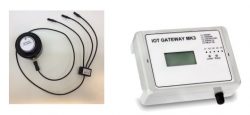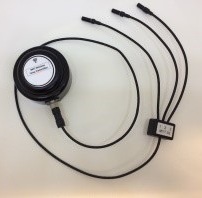
A manufacturing plant required a cost-effective solution for monitoring the bearing temperature of approximately 100 components on a large rolling machine spread over 150 metres. The key challenges were the high number of measurement points, the long distance, and the need for individual component alarm identification without installing extensive and expensive cabling.
- Customer Requirement: Monitor ~100 individual bearing temperatures.
- Installation Challenge: Components distributed over a linear distance of 150 metres.
- Alarming Needs: Provide specific, immediate alerts for each component if temperatures exceed 90°C.
- Key Driver: Avoid the high cost, complexity, and disruption of a traditional hard-wired sensor system.
A client in the industrial manufacturing sector approached us with a significant challenge regarding their plant’s machinery. They needed to implement a comprehensive temperature monitoring system for approximately 100 critical components, which were bearing housings on a very long production machine for paper processing. The primary goal was to establish a predictive maintenance program by continuously monitoring the temperature of these components. A crucial requirement was the system’s ability to trigger an alarm if any single component’s temperature exceeded a predefined threshold of 90°C, with the standard operating range being between 60°C and 80°C. Furthermore, the system had to pinpoint and display exactly which component was experiencing the high temperature to enable swift intervention by the maintenance team.
A major constraint was the physical scale of the installation. The monitoring points were distributed along a 150 metre stretch of the machine. This length made a traditional hard-wired sensor solution prohibitively expensive and complex to install, as it would require running extensive lengths of thermocouple or RTD extension wiring from each of the 100 points back to a central data acquisition system. The potential for signal degradation over such long cable runs and the physical disruption of installing the wiring conduit were significant concerns. The client was therefore specifically interested in a wireless solution that could overcome these physical and financial barriers while providing reliable, real-time data and alarming capabilities.
To meet the demands of monitoring numerous, widely distributed points on the machinery, a wireless temperature monitoring system was proposed. This solution was designed to be scalable, easy to install, and provide the detailed, actionable data the customer required for their predictive maintenance strategy.
The core of the solution begins at the measurement point. For each of the approximately 100 bearing housings, a dedicated temperature sensor probe is installed. These probes are connected to an IWTT-Node series wireless transmitter. A key advantage of this approach is the flexibility of the sensor probes. In locations where several bearing housings are clustered closely together, a multi-way sensor cable can be utilised, allowing a single IWTT-Node transmitter to handle multiple temperature inputs. This reduces the total number of wireless transmitters needed, simplifying the network and lowering the overall cost of the installation.
Each IWTT-Node transmitter is a compact, self-contained unit powered by a long-life 3.6V lithium battery. With a default transmission rate of every 10 seconds, the battery can last up to five years, drastically reducing the maintenance overhead associated with battery changes. The transmitter digitises the temperature reading from its connected probe(s) and transmits the data wirelessly.
The data from all the individual IWTT-Node transmitters is collected by a single, centrally located IoT Gateway. This gateway is capable of receiving data from up to 128 separate wireless transmitters, comfortably meeting the client’s requirement for 100 monitoring points. The system operates on the license-free 2.4 GHz frequency band and has a transmission range of up to 500 metres, which provides a robust communication link across the entire 150 metres length of the machine, and even better one with the gateway placed at the centre 75m from each end.
The IoT Gateway acts as the brain of the system. It aggregates all the incoming temperature data and leverages its built-in cellular modem to push this information to a remote, cloud-based server using the MQTT protocol. This architecture provides a significant advantage by keeping the monitoring system’s data traffic entirely separate from the plant’s internal IT network, simplifying installation and enhancing cybersecurity.
Maintenance engineers and operational technology staff can access the data through a secure, web-based SCADA platform from any internet-enabled device, such as a PC, smartphone, or tablet. This platform provides a real-time overview of the entire machine, with each of the 100+ temperature points clearly displayed. The system is configured to meet the customer’s critical alarming requirement: if any sensor reports a temperature above the 90°C setpoint, the system automatically sends an email or SMS text message alert to the designated maintenance personnel. The alert identifies the specific component in alarm, enabling the team to respond immediately and prevent potential equipment failure, thus fulfilling the primary goal of the predictive maintenance initiative. The platform also logs all historical data, allowing for trend analysis to identify bearings that may be degrading over time, even before they reach a critical alarm state.


IW Wireless Temperature Monitor with Cellular Modem Wireless Receiver Receiver
- Part No: II-TEMPCAB-000-03, IoT-Gateway
- Wireless Transmitters: Temperature Sensor Node & 3-way Temperature Sensor
- Wireless Receivers: 2G 3G 4G cellular modem
